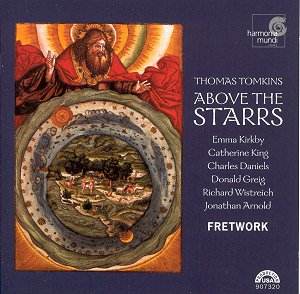Thomas
Tomkins was a composer who always remained a kind of 'outsider'
in the musical life in England. "From Worcester, Tomkins
came to Chapel Royal and court mainly for funerals and coronations,
or whenever his choral abilities were in demand," says David Pinto
in his liner notes. The court was dominated by composers of foreign
ancestry, like Bassano, Ferrabosco and Lanier. It is remarkable
that Tomkins in the dedication of his works never mentioned their
names, in contrast to English-born composers like Byrd, Dowland,
Gibbons and Coprario - who, despite his Italianised name, was
English (Cooper). His attempt to become court composer after the
death of Alfonso Ferrabosco II failed.
Tomkins
is rather moderate in expression: he avoids the extremes and strong
individualism of the works of younger contemporaries like William
Lawes and Matthew Locke. And only a small part of his musical
output became widely known, although it belonged to the standard
repertoire in Worcester.
This
recording gives an interesting insight into that part of his oeuvre
which centres around the 'consort of viols'. Some of the most
interesting works are his Fantazias in 6 parts. (The liner notes
refer to four of them, but in the track list I can see only three.)
One of them (VdGS No. 2) contains some heavy chromaticism. That
is also the case in the second part of the Pavan a 5, which begins
with a reworking of Dowlands 'Lachrymae'. The density of the Pavan
a 6 results in an almost orchestral sound. Its solemnity contrasts
nicely with the following Galliard a 6, a playful piece with lively
rhythms and imitation between the voices.
A
special kind of composition is the 'consort anthem'. There were
two kinds of anthems in the liturgy of the Church of England:
the 'full anthem' and the 'verse anthem'. The full anthem is written
for ‘choir’, whereas the verse anthem contains passages for solo
voices. In church, the verse anthem was usually accompanied by
the organ, but in the Chapel Royal there was the alternative option
of the viol consort. It was also at the court that the verse anthem
had its origins: it developed from the secular ‘consort song’:
a piece for solo voice and viols.
In
his verse anthems, Tomkins uses the solo passages to illustrate
the text. The most obvious example is the music going down and
up on the words "I will treade them downe, that rise up against
me" (Thou art my king). Repetition and the use of short notes
illustrate ‘time’ ("how longe" and "a spanne longe"
respectively) in the first piece on this CD, "O Lord, let
me knowe myne end". Most verse anthems start with a short
prelude for the viols, which set the tone for the whole piece.
The difference between the preludes of "Sing unto god"
and "Woe is me" is striking.
This
is a very recommendable recording. Tomkins’ music – with the exception
of his keyboard works and some sacred music – is poorly represented
on CD. That makes this recording especially welcome. And the music
recorded here is of such a quality that it is a delight to listen
to. The programme has been well put together, with its alternation
of vocal and instrumental works, and of more serious and ‘lighter’
items.
Fortunately
the music is well served by the performance. Fretwork is playing
superbly. There is no lack of expression, the choice of tempo
and the use of dynamics very convincing. And both the solemn and
more playful pieces get the best possible treatment.
All
the singers are well-known from the early music scene. Their voices
blend very well, and the individual contributions of most singers
are fine. It is great to hear Emma Kirkby in excellent form here.
This is the kind of music that suits her best. The only reservations
I have regard Richard Wistreich: his voice sounds a little stressed
in the upper register and his singing lacks a bit subtlety. On
the other hand, Charles Daniels is just brilliant and very expressive
in his solo contributions.
A
feature which makes this recording even more recommendable is
the use of Elizabethan pronunciation of the texts of the anthems,
which are also printed in the original spelling in the booklet.
The liner notes by David Pinto are very informative and the booklet
also contains information about the artists and the instruments
used in this recording.
Johan
van Veen

